Your smartphone can reveal hidden talents in street portrait photography. You'll discover how to harness natural light, capture authentic expressions, and frame shots for maximum impact. Urban backgrounds become your canvas as you learn to utilize unique textures and reflections. With the right editing apps, you can enhance your portraits while maintaining their raw energy. Developing timing and anticipation skills will help you capture those decisive moments. You'll also learn ethical approaches to photographing strangers and composition rules tailored for phone cameras. These secrets will transform your street portraits, revealing the artist within you. Dive deeper to uncover even more techniques.
Mastering Light and Shadows
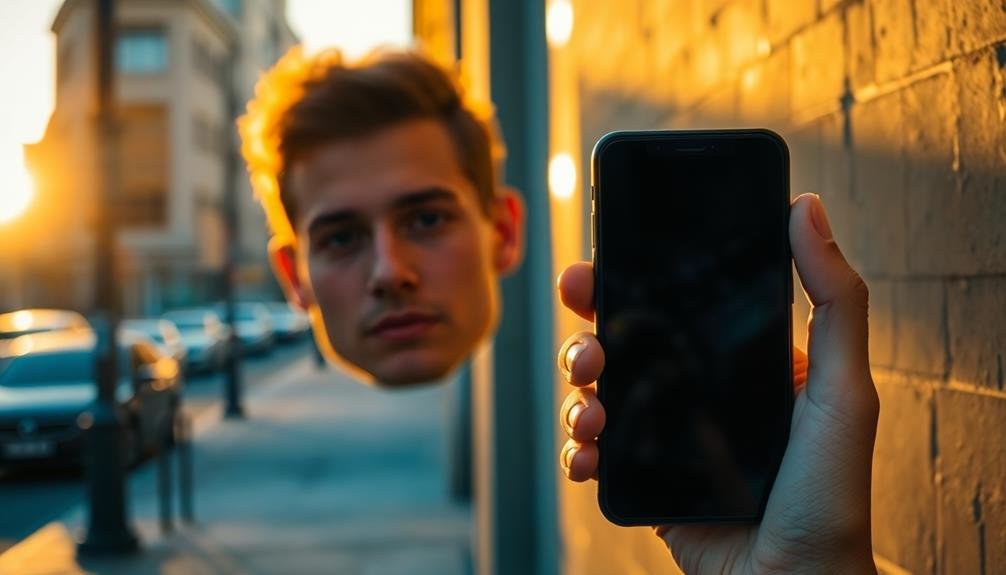
Harness the power of light and shadows to elevate your street portraits. Your phone's camera is a powerful tool for capturing compelling images when you understand how to manipulate light.
Look for natural light sources like sunlight filtering through trees or reflecting off buildings. These create interesting patterns and textures that can add depth to your portraits.
Pay attention to the direction of light. Side lighting can emphasize facial features and create dramatic shadows, while front lighting produces softer, more even illumination.
Experiment with backlighting to create silhouettes or rim lighting effects. Use your phone's exposure compensation feature to fine-tune brightness and contrast.
Don't shy away from shadows. They can add mystery and intrigue to your portraits. Look for areas with a mix of light and shadow, such as doorways or alleyways.
Use these elements to frame your subject and create visual interest. Try shooting during the golden hour—just after sunrise or before sunset—when the light is warm and soft, producing flattering portraits.
Capturing Authentic Expressions
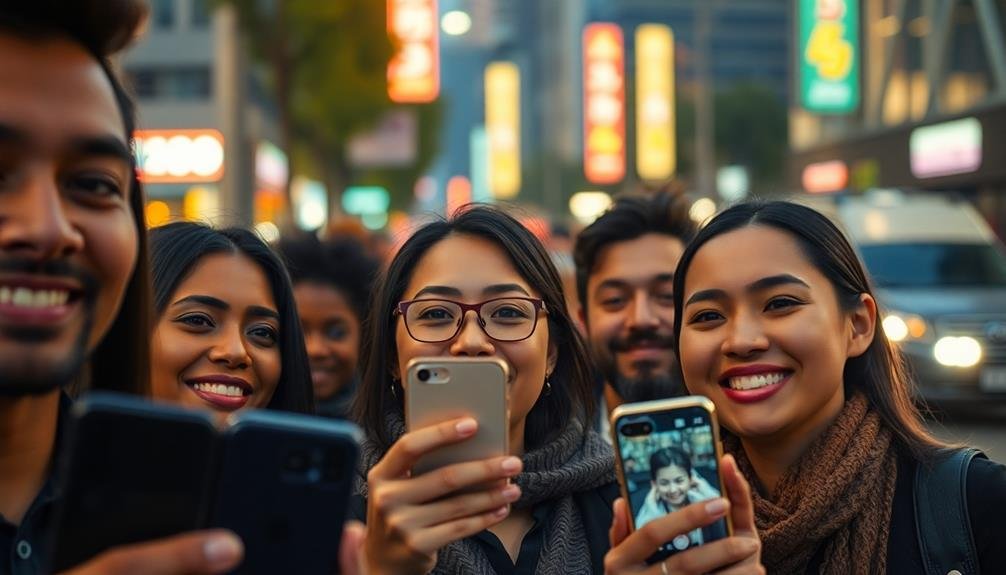
To capture authentic expressions in street portraits, you'll need to master three key elements.
First, engage with your subject to build rapport and elicit genuine reactions.
Second, decide between candid and posed shots, each offering unique opportunities for authenticity.
Engage With Your Subject
Engaging with your subject is the cornerstone of capturing authentic expressions in street portraits. When you approach someone for a photo, start with a friendly smile and introduce yourself. Explain your intent clearly and respectfully, letting them know why you'd like to photograph them. This initial interaction sets the tone for the entire shoot.
As you prepare to take the photo, keep the conversation flowing. Ask open-ended questions about their day, their outfit, or their surroundings. This helps your subject relax and forget about the camera. Pay attention to their body language and adjust your approach accordingly. If they seem uncomfortable, give them space or try a different angle.
Don't be afraid to give gentle direction. Suggest small adjustments to their pose or ask them to look in a specific direction. However, avoid over-directing, as this can lead to stiff, unnatural expressions.
Instead, encourage your subject to be themselves. Compliment them genuinely and show enthusiasm for the shoot. This positive energy often translates into more relaxed, authentic expressions in your final images.
Candid vs. Posed Shots
When it comes to street portraits, you'll often find yourself balancing between candid and posed shots. Candid photos capture authentic, unguarded moments, while posed shots allow for more control over composition and expression. Both have their merits, and mastering both techniques will elevate your street photography.
For candid shots, you'll need to be quick and discreet. Use a fast shutter speed to freeze motion and capture fleeting expressions. Anticipate moments and be ready to shoot at a moment's notice. Don't be afraid to take multiple shots in rapid succession to increase your chances of capturing the perfect moment.
Posed shots require a different approach. Here's how to get the best results:
- Establish rapport with your subject to help them relax
- Give clear, simple directions for posing
- Encourage natural expressions by engaging in conversation
Timing Is Everything
Capturing authentic expressions in street portraits hinges on impeccable timing. You'll need to develop a keen eye for fleeting moments and quick reflexes to seize them. Watch for subtle changes in your subject's face, like a sudden smile or a contemplative look. These split-second shifts can transform an ordinary shot into a compelling portrait.
To improve your timing, practice anticipating moments before they happen. Observe people's body language and interactions. If you spot a potential subject, ready your phone and wait for the right instant.
Don't be afraid to take multiple shots in rapid succession; you can always select the best one later. Consider using your phone's burst mode or a third-party camera app with a fast shutter speed. This will help you capture a series of images quickly, increasing your chances of nailing that perfect expression.
Framing Techniques for Impact
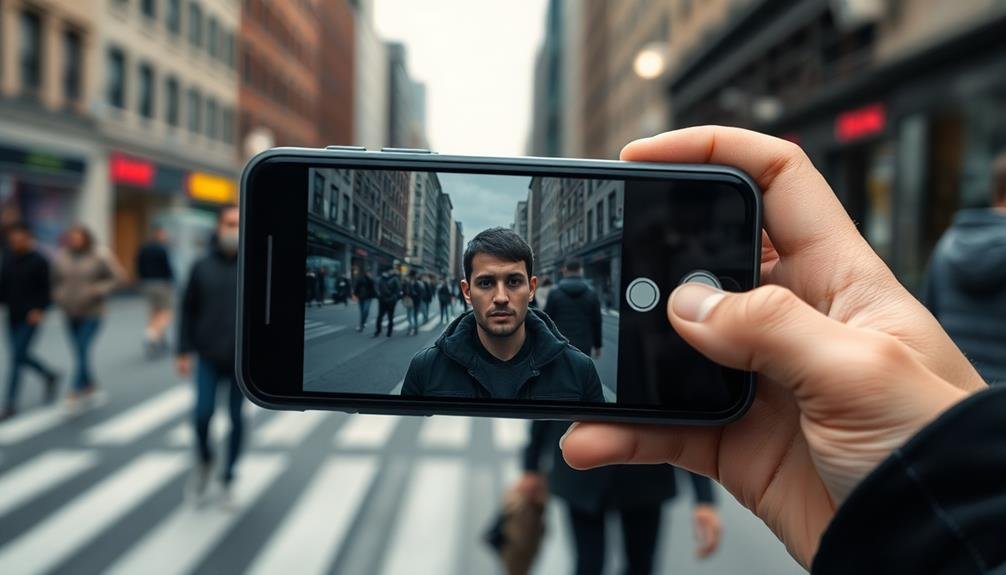
Framing techniques can make or break a street portrait's impact. As you compose your shot, consider how you'll use the surrounding environment to enhance your subject. Look for natural frames like doorways, arches, or even shadows to draw attention to your subject. Don't be afraid to get creative with unconventional framing elements like reflections in windows or puddles.
Remember these key framing techniques:
- Rule of thirds: Place your subject off-center for a more dynamic composition.
- Leading lines: Use streets, buildings, or other linear elements to guide the viewer's eye to your subject.
- Negative space: Incorporate empty areas around your subject to create a sense of isolation or emphasize their presence.
Experiment with different angles and perspectives to find the most impactful framing. Try shooting from low angles to make your subject appear more powerful, or from above to capture a unique viewpoint.
Pay attention to the background and guarantee it complements rather than distracts from your subject. By mastering these framing techniques, you'll elevate your street portraits from ordinary snapshots to compelling visual stories that captivate viewers and showcase your subjects in their best light.
Utilizing Unique Urban Backgrounds
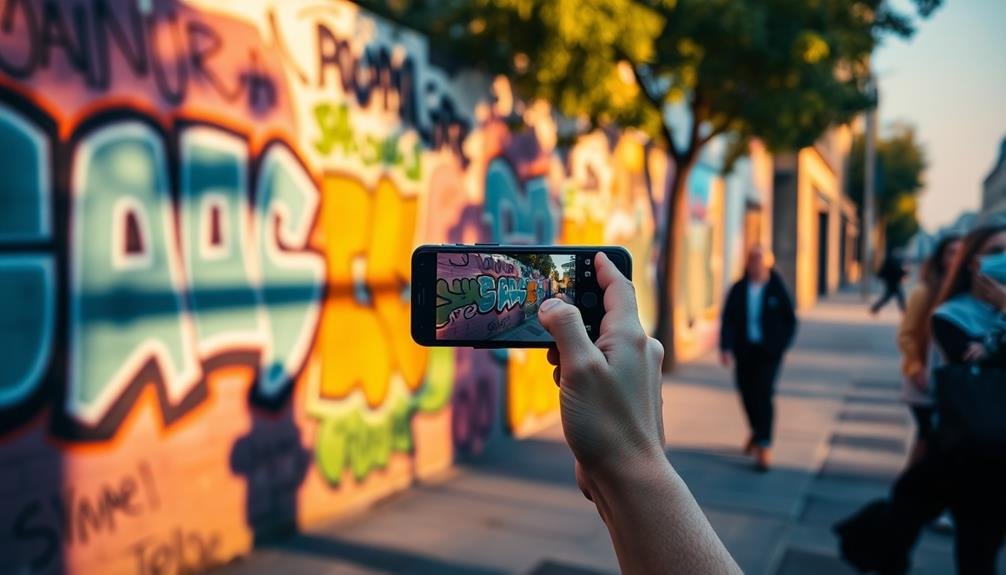
Urban environments offer a treasure trove of unique backgrounds for street portraits. You'll find endless opportunities to capture stunning images by leveraging the city's diverse textures, colors, and structures.
Look for interesting wall murals, colorful graffiti, or weathered brick facades to add depth and character to your shots. Don't overlook architectural elements like arches, doorways, or staircases that can frame your subject in intriguing ways.
Consider the interplay of light and shadow in urban settings. Alleyways, underpasses, and narrow streets can create dramatic lighting effects that enhance your portraits.
Pay attention to reflective surfaces like windows, puddles, or metallic structures that can add visual interest or create unique compositions.
Experiment with contrasting elements in your backgrounds. Juxtapose your subject against modern skyscrapers or historic buildings to tell a visual story.
Incorporate urban greenery, such as park benches or tree-lined streets, to add a softer touch to the concrete jungle.
Remember to keep your subject in focus while using these backgrounds to complement, not overpower, your portrait.
Editing Apps for Street Portraits
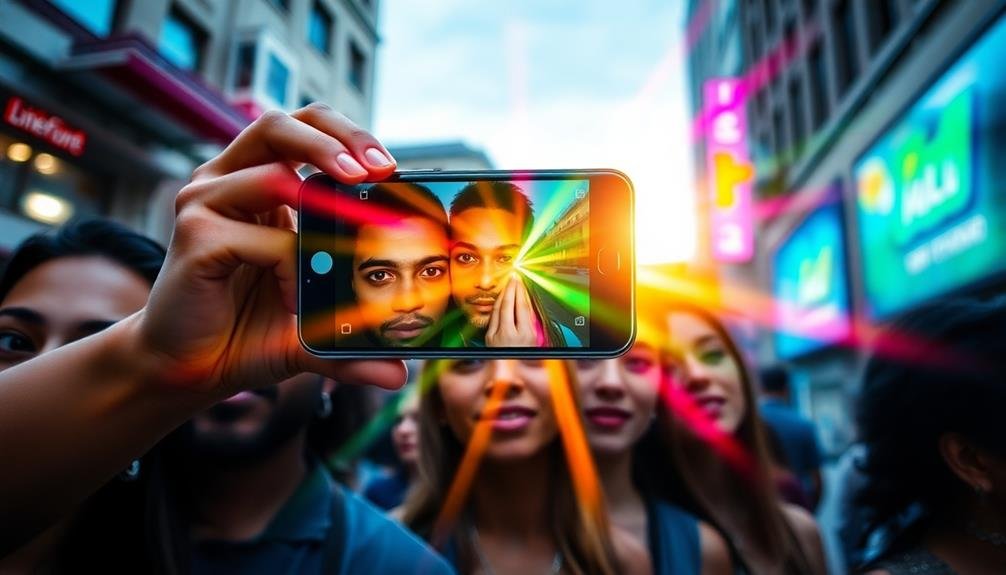
Once you've snapped your street portraits, editing apps can take your images to the next level. Your smartphone is a powerful tool, not just for capturing moments but also for enhancing them.
With the right apps, you can transform ordinary shots into striking works of art that capture the essence of urban life.
When choosing editing apps for street portraits, look for those that offer:
- Precise exposure and contrast controls to highlight your subject against busy backgrounds
- Color grading options to create a cohesive mood across your street photography series
- Selective editing tools to emphasize specific areas of your portraits without affecting the entire image
Popular apps like VSCO, Snapseed, and Lightroom Mobile provide these features and more. They allow you to adjust shadows and highlights, fine-tune colors, and even remove distracting elements from your shots.
Don't be afraid to experiment with different filters and presets, but remember to maintain the authenticity of the moment you've captured. The goal is to enhance, not overpower, the raw energy of street portraits.
With practice, you'll develop a signature editing style that brings your unique vision of urban life to the forefront.
Approaching Strangers Ethically
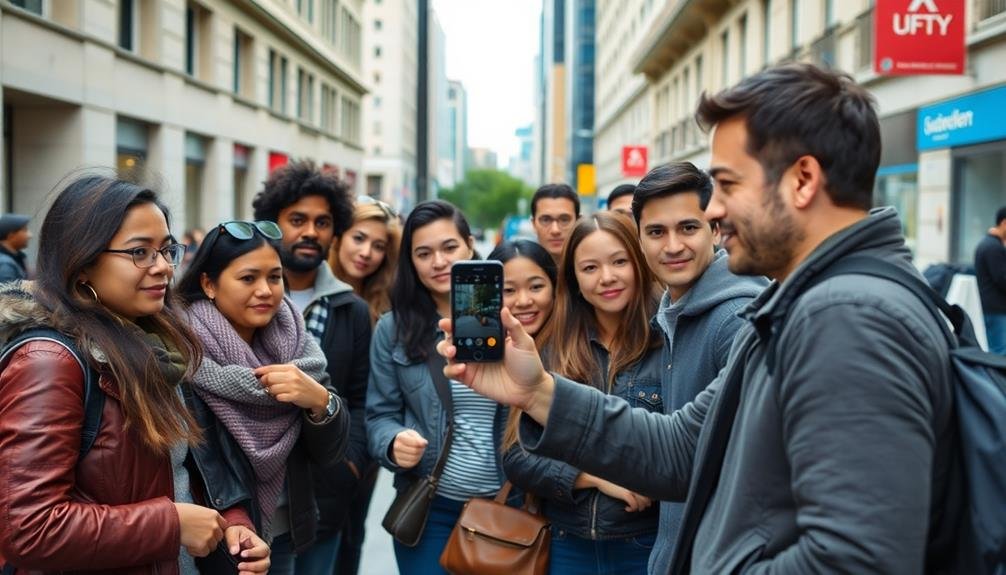
While editing can enhance your street portraits, the most important aspect of this art form is how you interact with your subjects. Approaching strangers ethically requires respect, empathy, and clear communication.
Start by making eye contact and offering a friendly smile. Introduce yourself and explain your intent to take street portraits. Be transparent about how you'll use the photos and offer to share them with your subject.
Always ask for permission before taking someone's picture. If they decline, respect their decision and move on. When you do get consent, engage in a brief conversation to help your subject feel at ease. This can lead to more natural, expressive portraits.
Be mindful of cultural sensitivities and personal boundaries. Consider offering something in return, like a digital copy of the photo or a small print. This gesture can build goodwill and create a positive experience for both you and your subject.
Timing and Anticipation Skills
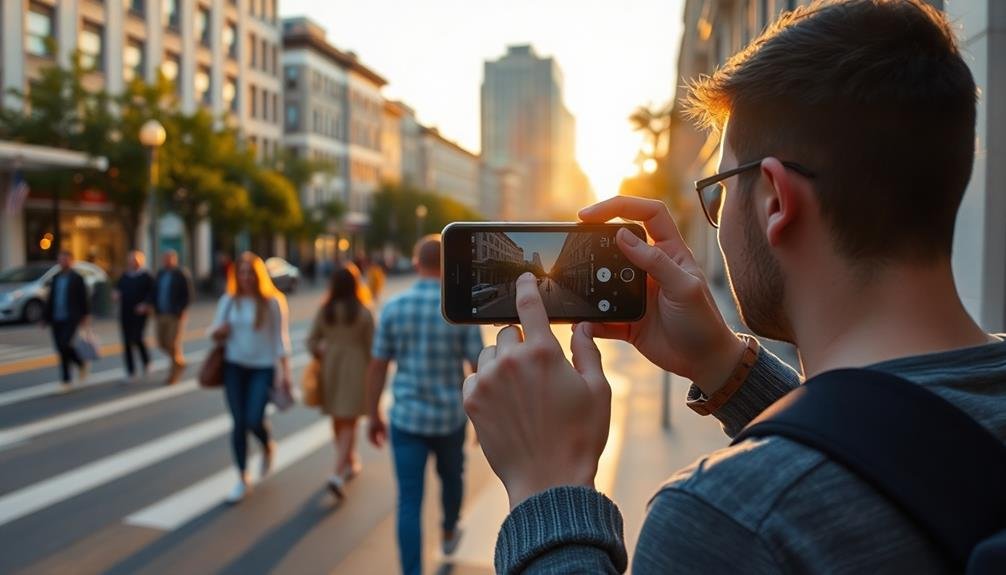
You'll need razor-sharp timing to excel at street portraits.
Practice capturing fleeting expressions and predicting subject movements to elevate your shots.
Capturing Fleeting Expressions
The art of capturing fleeting expressions lies in split-second timing and keen anticipation.
You'll need to develop a sixth sense for those brief moments when emotions flash across a subject's face. Train your eye to recognize micro-expressions and be ready to snap the shutter at the perfect instant.
To improve your ability to capture these fleeting moments:
- Practice continuous observation: Always be scanning your environment for potential subjects and interesting expressions.
- Pre-focus your camera: Set your focus point in advance to minimize lag time when you spot a compelling expression.
- Use burst mode: Increase your chances of capturing the perfect moment by taking multiple rapid-fire shots.
Predicting Subject Movements
Successful street photographers often excel at predicting subject movements, allowing them to capture decisive moments with precision. You can develop this skill by observing patterns in pedestrian behavior and anticipating their next moves. Watch for subtle cues like changes in walking speed, shifts in body language, or eye movements that indicate a person's intended direction.
Practice timing your shots by pre-focusing on a specific spot and waiting for subjects to enter the frame. This technique helps you capture spontaneous moments without relying solely on autofocus. Pay attention to the flow of foot traffic and identify natural bottlenecks or gathering points where interesting interactions are likely to occur.
| Technique | Purpose | Example |
|---|---|---|
| Observe patterns | Anticipate movements | Commuter rush hour |
| Read body language | Predict actions | Sudden head turn |
| Pre-focus | Improve timing | Doorway or street corner |
| Identify hotspots | Find interactions | Busy intersections |
Mastering Decisive Moments
Capturing the decisive moment is perhaps the most critical skill in street photography. It's that split second when all elements align perfectly, creating a powerful image that tells a story. To master this art, you'll need to hone your timing and anticipation skills.
Start by observing your surroundings intently. Look for patterns in people's behavior, anticipate their movements, and predict potential interactions. You'll soon develop an intuition for when something interesting is about to happen.
To improve your chances of capturing these fleeting moments:
- Keep your camera ready at all times, with settings pre-adjusted for your environment.
- Practice quick framing and focusing techniques to minimize lag time.
- Learn to shoot from the hip, allowing for more discreet and spontaneous captures.
Remember, the decisive moment isn't just about timing; it's about composition too. Train your eye to recognize when visual elements come together in a compelling way. Look for juxtapositions, contrasts, and unexpected connections between subjects and their environment.
With practice, you'll develop a sixth sense for these magical moments, enabling you to create powerful street portraits that capture the essence of life unfolding before you.
Composition Rules for Smartphone Portraits
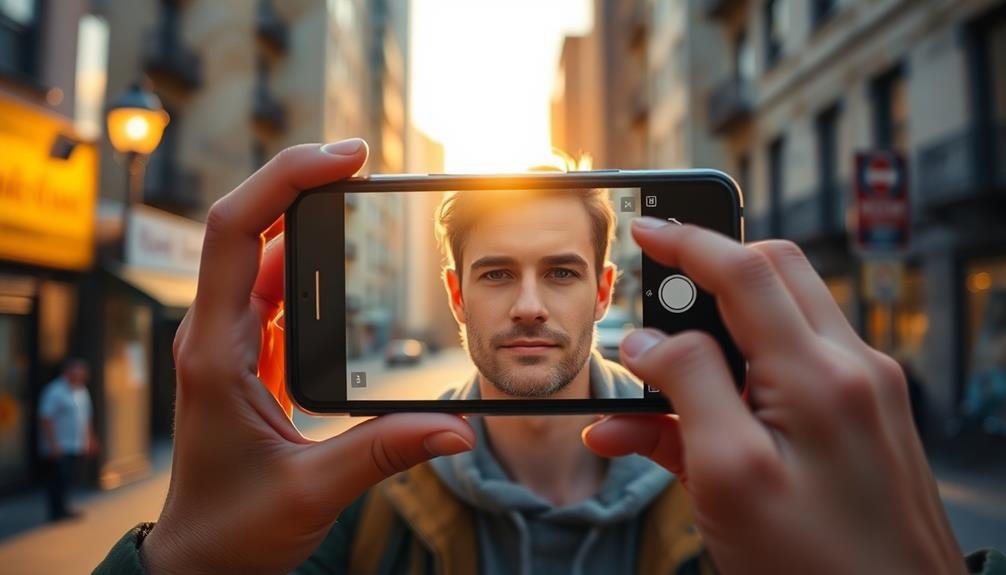
Mastering composition rules can dramatically elevate your smartphone portraits from ordinary snapshots to intriguing works of art. Start with the rule of thirds: imagine your screen divided into a 3×3 grid and place your subject along these lines or at their intersections. This creates a more balanced and visually appealing image.
Pay attention to leading lines in your environment. Use streets, buildings, or natural elements to guide the viewer's eye towards your subject. Frame your subject creatively using doorways, windows, or foliage to add depth and context to your portrait.
Don't forget about negative space. Leaving empty areas around your subject can create a powerful, minimalist effect. Experiment with symmetry and patterns in your backgrounds to add visual interest.
For a unique perspective, try shooting from low angles or tilting your phone slightly. This can make your subject appear more dominant or create a sense of dynamism.
Lastly, consider the background carefully. A cluttered backdrop can distract from your subject, so look for clean, simple backgrounds that complement rather than compete with your portrait.
Frequently Asked Questions
How Do I Protect My Phone From Theft While Shooting Street Portraits?
Stay alert and keep your phone close. Use a wrist strap or secure case. Don't leave it unattended. Be aware of your surroundings. Consider using a less expensive backup phone for shooting. Always have a backup plan.
What Are the Legal Considerations for Street Photography in Different Countries?
You'll find street photography laws vary widely by country. In some places, you're free to shoot in public. Others require consent. Research local regulations, respect privacy laws, and be aware of restrictions on commercial use.
How Can I Stabilize My Phone for Sharper Street Portraits?
You can stabilize your phone for sharper street portraits by using a mini-tripod or grip accessory. Hold your phone with both hands, tuck your elbows in, and use burst mode. Lean against walls or objects for extra support.
What Clothing Should I Wear to Blend in During Street Photography?
You'll want to wear neutral, unassuming clothes that don't draw attention. Opt for dark or muted colors, avoid flashy logos or patterns. Dress casually and comfortably, like a local. This'll help you blend in and capture authentic street scenes.
How Do I Handle Confrontations or Rejections When Approaching Subjects?
When faced with confrontations or rejections, stay calm and respectful. Explain your intentions clearly, offer to show them the photos, and be prepared to delete if asked. Don't argue or push; gracefully accept their decision and move on.
In Summary
You've now revealed the secrets to capturing stunning street portraits with your smartphone. By mastering light, framing, and composition, you'll create impactful images that tell compelling stories. Remember to approach subjects ethically and hone your timing skills. With practice, you'll develop an eye for unique urban backgrounds and authentic expressions. Don't forget to experiment with editing apps to enhance your shots. Now go out there and let your phone unveil the hidden stories of the streets!

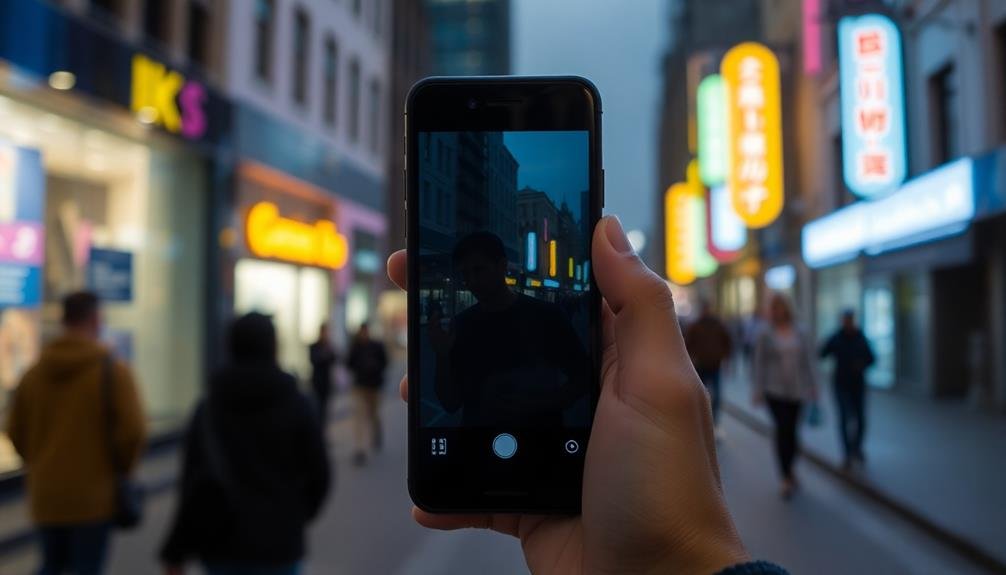
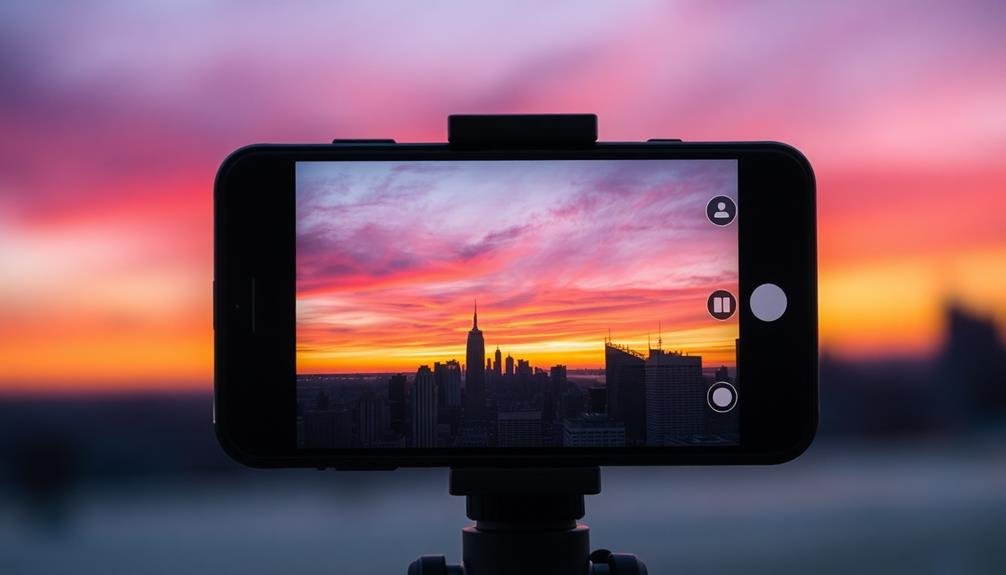


Leave a Reply